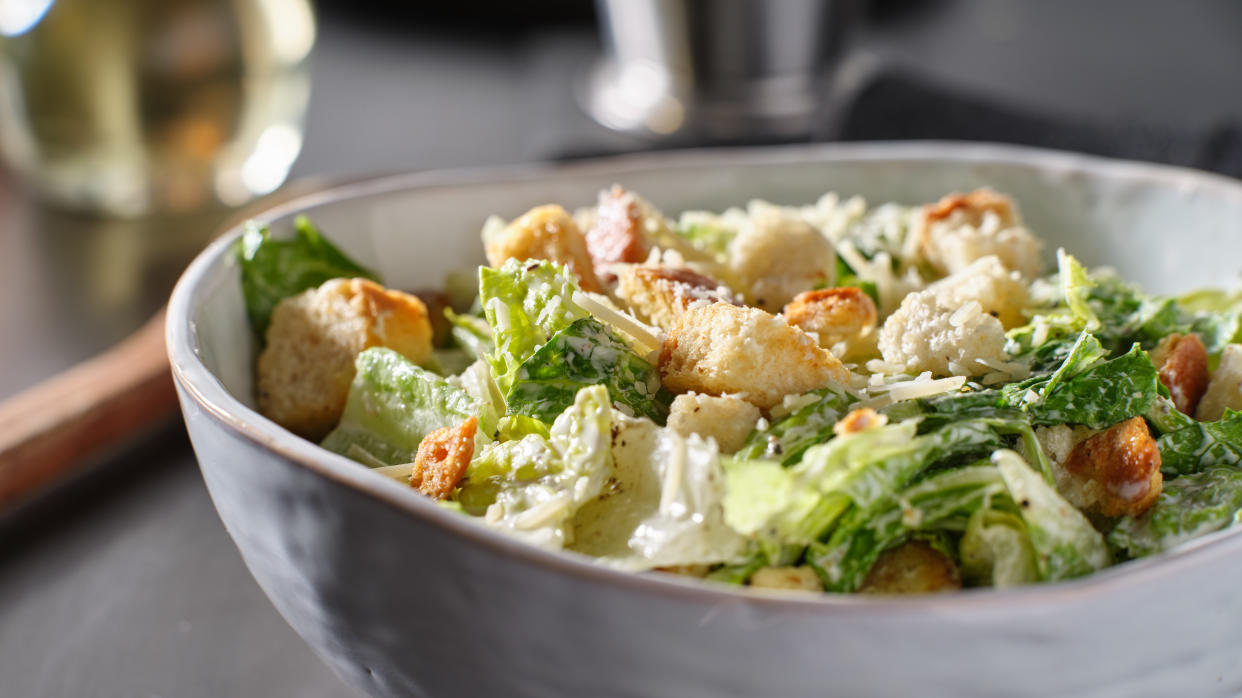Caesar salad is traditionally made with raw egg yolk. Try these alternatives for a safer dressing.

Can a salad be a comfort food? If you’re a Caesar salad enthusiast, your answer is likely “heck, yes” — and with the Caesar salad turning 100 this year, you may be thinking about making one yourself. After all, Caesar dressing turns lettuce (not the most exciting food on the planet, if we’re being honest) into cheesy, umami goodness, thanks to a mix of flavors like lemon juice, garlic, Dijon mustard, anchovies and Worcestershire sauce.
While anchovies are certainly a “love ‘em or leave ‘em” ingredient (and plenty of Caesar salads skip them entirely in favor of vegan substitutes like miso paste or capers) there is one historic ingredient in Caesar salad that gives many people pause. Raw egg yolk is traditionally used in Caesar salad in order to help the dressing achieve its beloved creaminess — but not every expert is sold on the ingredient, which is linked to a heightened risk of foodborne illness.
Here’s what you need to know about raw egg in your dressing, and why experts say it’s best to skip.
How do you make a Caesar salad with raw egg?
There are different ways to craft a Caesar salad. However, a simple traditional recipe that uses eggs looks like this:
Gather romaine lettuce, croutons, Parmesan cheese, olive oil, lemon juice, Dijon mustard, Worcestershire sauce, garlic, raw egg, salt and pepper.
Whisk together a raw egg, two minced garlic cloves, one tablespoon Dijon mustard, one tablespoon Worcestershire sauce, lemon juice, salt and pepper.
Whisk in half a cup of olive oil until the dressing is emulsified and creamy.
Toss chopped romaine lettuce with the dressing until evenly coated. Add croutons and shaved or grated Parmesan cheese on top of the salad. Serve immediately.
What do experts say about raw egg in Caesar salad?
It’s worth noting that this isn’t the only time that you may eat a raw egg. Many cocktails, including eggnog, use eggs in order to create a foamy, creamy texture. Hollandaise sauce may also contain raw egg, as do some traditional recipes for tiramisu. Some people even drop raw eggs into their smoothie for an extra protein boost.
But food scientist Bryan Quoc Le tells Yahoo Life that it is unsafe to use raw egg in recipes. The reason? “Salmonella can contaminate both the exterior of the egg shell from chicken fecal matter and the interior of the egg as the egg develops,” he explains. Cooking eggs to an internal temperature of 160°F kills off this salmonella bacteria.
Salmonella is a bacteria that causes foodborne illness, including symptoms like diarrhea, abdominal cramps, fever, nausea, vomiting and in severe cases, an infection that spreads from the intestines to the bloodstream to other parts of the body. It’s particularly dangerous for young children, the elderly, pregnant people and those with weakened immune systems.
There is, however, a way to use eggs safely — or, at least, considerably safer, Le says. “Eggs that have been previously pasteurized can be used safely without cooking, as these eggs have been heat treated in such a way that the salmonella has been destroyed,” he notes. Mayonnaise, for example, typically contains pasteurized eggs, per recommendations from the U.S. Department of Agriculture.
If you’re intending to make Caesar salad dressing with raw egg, you can seek out these pasteurized eggs at the grocery store. They’re typically more expensive, but not getting food poisoning is worth it, right?
What else can you use if you don’t want to use raw egg?
Jessica Chan, a former chef turned food blogger, tells Yahoo Life that store-bought mayonnaise, which is made from pasteurized eggs already, is “a great substitute for raw eggs because it has a creamy texture and a similar flavor profile.”
You can also go a completely different route, Celine Beitchman, director of nutrition at the Institute of Culinary Education, tells Yahoo Life. “At the Institute of Culinary Education, we make a vegan Caesar dressing with silken tofu as the emulsifier, and hing (also known as asafetida) or black sulfurous salt (also called kala namak) for eggy flavor, in place of eggs,” she explains.
Other Caesar salad recipes call for ingredients like hummus, avocado, yogurt-based dressings or even tahini to replace traditional components like raw egg.
If you do go to a restaurant and are concerned about the safety of your Caesar salad, you can ask the server if raw egg is used. According to the Food and Drug Administration, commercial dressings and sauces contain pasteurized eggs that are safe to eat.
What else should I worry about with Caesar salad?
It’s not just the raw egg you should be wary about in terms of food safety; lettuce itself can run the risk of being contaminated with salmonella. “When making any salad, be sure to wash your hands carefully before handling food, and wash lettuce leaves under running water or in a salad spinner,” dietitian Kelly LeBlanc, vice president of nutrition programming at the nutrition-focused nonprofit Oldways, tells Yahoo Life.
Le says that you also want to be cautious about your salad on a hot day, such as if you’re bringing your dish to a picnic. Mayonnaise and even garlic can be particularly risky, but in general, food left out at above 40°F for more than two hours can lead to bacteria growth, which can cause foodborne illness. To be extra-cautious, you can pack a cooler with ice to keep your salad bowl chilly until it’s time to eat.


